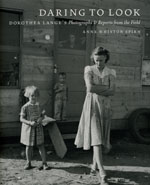An excerpt from
Daring to Look
Dorothea Lange’s Photographs and Reports from the Field
Anne Whiston Spirn
“I went home that day a discoverer, a real social observer”
Who was, who is, Dorothea Lange? Lange was forty years old when she made the photograph “Migrant Mother.” She had recently reinvented herself professionally. She had been a portrait photographer in San Francisco, her clients from wealthy families, the direct opposite of the “people in trouble” whose photographs were to make her famous. Not until she was thirty-seven, in 1933, did she take her camera down from her upstairs studio on Montgomery Street into the gritty city, where the Depression was “beginning to cut very deep.” And on that first day, she made a photograph that was to become one of her most celebrated, “White Angel Breadline.” (Her print of that photograph sold in 2005 for $822,400 at Sotheby’s in New York, at the time a match for the highest price ever paid at auction for a twentieth-century photograph.)
 Figure 5. White Angel Breadline. San Francisco, California. 1933. |
|
When exactly, and why, did Lange decide to photograph “people in trouble”? Her own accounts vary, though all entail a struggle to redefine her professional identity. In an interview during the 1960s, she tells of watching from the upstairs window of her studio as the unemployed drifted past in 1933, and of deciding to take her camera to the street. But, in an account from the 1950s, she reports that the decisive moment occurred earlier, in a clap of “thunder bursting and…wind whistling” in the summer of 1929, as if foreshadowing the stock market crash a few months later. She decided then to “concentrate upon people, only people. All kinds of people, people who paid me and people who didn’t.” Whether or not the conversion was really so melodramatic, Lange’s transformation from portrait photographer of the urbane wealthy to “field investigator, photographer” (the title of her first job with the federal government in 1935), was life-changing.
As Lange went down to the streets of San Francisco in 1933, Franklin Delano Roosevelt was launching the New Deal to address the national economic emergency. Urgency, fear, and hope were in the air. In his first Hundred Days, FDR issued executive orders establishing a host of programs and agencies to provide relief and create jobs for the poor and the unemployed. Lange, on San Francisco’s skid row, was photographing men sleeping on sidewalks, leaning against storefronts; one man sat slumped, head bowed, next to an overturned wheelbarrow. In 1934, Lange and Dixon, though living apart, were portraying similar scenes, Dixon’s paintings of a man sitting on a curb and men leaning against buildings echoing Lange’s photographs. Or perhaps her work echoes his, framing views from the same low perspective. Probably the influence was mutual.
Before the San Francisco general strike broke out, on July 16, 1934, Lange had already photographed demonstrations: men with fists raised, mouths open, shouting. When the strike erupted among longshoremen, she entered the crowds to make portraits of participants and spectators: men gripping placards; a policeman in the street, with gleaming badge and buttons; a crowd of men in fedoras and overcoats, shirts and ties. When she put up on the walls of her studio prints of the demonstrations, the general strike, and the unemployed men on San Francisco’s streets, her privileged clients asked, “But what are you going to do with it?” She did not yet know and could not answer.
That summer, Willard Van Dyke exhibited Lange’s street photographs at his gallery in Oakland. Paul Taylor, who was teaching economics at Berkeley and saw the exhibit, phoned to ask whether he might use a photograph for Survey Graphic, a leading social science journal of the day. Lange said yes, and her photograph of a man shouting into a microphone appeared with an article by Taylor and Norman Gold. Taylor, who had known the Survey Graphic editor, Paul Kellogg, for many years, had written for the journal previously, including an article on migrant workers from Mexico with photographs by himself and by Ansel Adams. “My method in the field is to observe, then select,” he said later. “By the time you statisticians know the numbers, what I’m trying to tell you about in advance will be history, and you’ll be too late.” When the California Emergency Relief Administration (SERA) appointed Taylor as field director for rural rehabilitation and charged him to assess the situation of agricultural laborers, Taylor decided that “words alone could not convey the conditions”; he must show “what the real conditions were like,” and to accomplish this he hired a photographer—Dorothea Lange. Ten months later, they were married.
In January 1935, Lange, on her first trip for the new job, accompanied Taylor to California’s Imperial Valley to observe and report on farm laborers living in hovels made of cartons, branches, and scraps of wood and cloth, with primitive privies, no waste disposal, no potable water. Lange began to write as well, impressed by the “life histories” a young Mexican woman on Taylor’s team of researchers was bringing back, and from then on she asked questions or listened and wrote down what people said about the hardships they faced (“Pretty hard on us now / Water standing on the quilts when we got up this mornin’”), what they earned (“15 a hamper”), where they came from (“Born…raised in the state of Texas—farmed all my natural life”). Thirty years later, the excitement of that early fieldwork was still fresh for Lange, particularly the memory of the rainy afternoon when she met the first Dust Bowl migrants. “We’ve been blown out,” they told her. “That was the beginning of the first day of the landslide that cut this continent,” she recalled. “I went home that day a discoverer, a real social observer.”
Lange’s photographs and her field notes provided the raw material for a new sort of government report: essays comprising photographs with handwritten captions, many with quotations from the people she photographed. For that first assignment, she combined, in a spiral-bound document, Taylor’s longer texts (including statistics) with her own hybrid essays, and maps drawn by Maynard Dixon. That first report by Lange and Taylor, “Establishment of Rural Rehabilitation Camps for Migrants in California,” requesting federal funds to build twenty to thirty camps with “decent housing,” could not have been more effective. At the meeting of the SERA commissioners, Taylor’s boss (who had been skeptical about hiring a photographer) pulled out Lange’s sheets of captioned photographs and passed them around the table, whereupon the members voted to fund the camps. Later, though, someone challenged the state commission’s authority to allocate federal money, for the camps were controversial. After the general strike of 1934, conflicts between growers and workers became increasingly violent, growers fearing that workers in government camps would organize and labor organizers fearing that the camps would stifle such collective action. Not until a federal official went out into the field with Taylor and Lange to observe living conditions firsthand were funds allocated to construct two camps, the first federally funded housing in the United States, Taylor said. Taylor has been called the father of the migratory camp program in California. If he was the father, then Lange was the mother.
 Figure 6a. “Migration of Drought Refugees to California.” April 1935. |
|
 Figure 7a. “First Rural Rehabilitation Colonists, Northern Minnesota to Matanuska, Alaska.” First page. May 1935. |
|
Two years into FDR’s first term, the nation’s capital was on fire with new executive orders and new legislation. The Works Progress Administration was creating jobs for unemployed workers, from laborers to artists. Roosevelt had signed the Social Security Act to provide pensions and unemployment insurance, a sea change in American society. Agencies created two years before were now being revised, moved, and reformed under new names within new structures, their staffs reshuffled and expanded. One of these was the Resettlement Administration, consolidating several existing programs, including a low-interest loan program to help poor farmers buy land. Among those recruited to go to Washington, D.C., to staff the new Resettlement Administration was Lewis Hewes, who had authorized Lange’s original appointment to work with Taylor. Hewes took along to Washington copies of Lange’s and Taylor’s reports to show to his new boss, Rexford Tugwell, and also to Secretary of Agriculture Henry A. Wallace, Secretary of the Interior Harold Ickes, and Eleanor Roosevelt. Lange’s photographs had a “powerful effect” in Washington, Hewes told one of Lange’s biographers: “She was about the most important thing in the whole show.” He arranged for her to be hired as “field investigator, photographer” in the agency’s Information Division, based in California and with responsibility for five states. Two years from the time Dorothea Lange stepped down from her studio in San Francisco to take her camera into the streets, she was ready to photograph the New Deal. She knew what she wanted to do, and what she would do for the rest of her life.
“We unearthed and discovered what had been… neglected, or not known”
“Open yourself as wide as you can…like a piece of unexposed, sensitized material,” like film itself. That was Lange’s way of working. “It is often very interesting,” Lange noted in the early 1960s, “to find out later how right your instincts were, if you followed all the influences that were brought to bear on you while you were working in a region.…It did happen more than once that we unearthed and discovered what had been either neglected, or not known, in various parts of the country, things that no one else seemed to have observed in particular, yet things that were too important not to make a point of.” Lange would prepare for a trip to a new area by consulting knowledgeable peers and “looking up data,” believing that “it is not enough to photograph the obviously picturesque.” She did not delve deeply into books before a trip, instead reading in the field or after returning, to make sense of what she had seen and to put the photographs in context. “To know ahead of time what you’re looking for means you’re then only photographing your own preconceptions, which is very limiting, and often false.” Too much reading in advance prejudiced the eye.
 Figure 8. Dorothea Lange photographing at a migrant camp. 1937. Rondale Partridge. |
|
 Figure 10. Dorothea Lange, Resettlement Administration photographer. February 1936. |
|
On assignment for the FSA, Lange usually photographed every day, from early morning into the evening. At night, she wrote letters and prepared for the next day’s work: “Have just finished loading and unloading the films. It’s late, I’m tired. Had a good day today but I’m done up—and there are all those notes and explanations, essays on the social scene in California is what they should be—still to be done.” To supplement her notes, Lange clipped stories from local newspapers and gathered research reports, pamphlets, and memos written by local FSA staff. Although she sometimes stayed in one place for several days, she often had to travel several hundred miles in a day. If an assistant was along, they might travel all night, taking turns driving and sleeping, or sleeping in a single room in an auto court, like those in California’s Central Valley between U.S. 99 and the railroad tracks, where the roar of trucks and the clanking of trains resounded throughout the night. “[It] was hard, hard living,” Lange recalled, “…not too far away from the people we were working with.”
Open herself, Lange found it easy to get people to open up to her. She would ask for directions as a way into a real conversation. She might speak to someone standing at the opening of a tent, on a doorstep, in a field, beside a car: Where had they come from? Where were they going? Who was living or traveling with them? How were they managing? What were their plans? There was no emotional distance between Lange and her subjects. Ben Shahn, in contrast, sometimes used an angle-finder on his lens so that people did not know he was photographing them. It is hard to imagine Lange’s employing such a technique. “I never steal a photograph,” she told Partridge. “Never. All photographs are made in collaboration, as part of their thinking as well as mine.” She wanted rapport with those she photographed, and she sensed when she had it; she considered her subjects complicit in the creation of their own portraits. Many of the individuals she photographed are shown speaking to her or pausing to reflect, their expressions revealing. She usually took more than one photograph of each person; in one an expression may be grave, in another a smile flashes.
Lange was patient:
Often it’s just sticking around and being there, remaining there, not swooping in and swooping out in a cloud of dust; sitting down on the ground with people, letting the children look at your camera with their dirty, grimy, little hands, and putting their fingers on the lens, and you let them, because you know that if you will behave in a generous manner, you’re very apt to receive it.…I have asked for a drink of water and taken a long time to drink it, and I have told everything about myself long before I asked any question. “What are you doing here?” they’d say. “Why with your camera? What do you want to take pictures of us for? Why don’t you go down and do this, that, and the other?” I’ve taken a long time, patiently, to explain, and as truthfully as I could.
 |
|
 Figure 11. Dorothea Lange, changing places with an agricultural worker. 1937. Rondal Partridge. |
|
Lange turned others’ hostility to advantage: “You go into a room and you know where you’re welcome; you know where you’re unwelcome.…Sometimes in a hostile situation you stick around because hostility itself is important.…The people who are garrulous and wear their heart on their sleeve and tell you everything, that’s one kind of person, but the fellow who’s hiding behind a tree and hoping you don’t see him is the fellow that you’d better find out why.”
When Paul Taylor accompanied Lange in the field, he too engaged people in conversation and took notes while she photographed; the two paused at intervals to confer and record what Lange had heard. “Her method of work,” he recalled later, “was often to just saunter up to the people and look around, and then when she saw something that she wanted to photograph, to quietly take her camera, look at it and if she saw that they objected, why she would close it up and not take a photograph, or perhaps she would wait until…they were used to her.…Then she would take the photograph, sometimes talking with them, sometimes not.…My purpose was just to make it a natural relationship, and take as much of their attention as I conveniently could, leaving her the maximum freedom to do what she wanted.…But you can see on how many great occasions she didn’t need my help.” Entries in her daybooks for August 1939 in both Taylor’s handwriting and hers reflect their easy, cooperative working relationship; they passed the daybook back and forth. “A good deal of the discipline that I needed in order to get hold of such an assignment—some of them had a very broad base—he gave me on those trips,” said Lange. “I learned a good deal from Paul about being a social observer.”
“I am writing captions until my fingers ache to say nothing of my head,” Lange told Roy Stryker, her boss at the FSA, in 1937. “This is no small job.…Am not sending it on to you in sections, as I had originally planned because I am making cross-references.…It’s not the individual captions that [take] the time but it’s the arrangement and grouping. If this is not done I believe that half the value of fieldwork is lost.” And two weeks later: “I am not yet through with this g-d-captioning job by any means although I’m working on it just as hard as I can. Sometimes it goes fast but sometimes I get stuck and have to go walk around the block or dig in the garden. I write ‘tenant farmer’ and ‘Mississippi’ in my sleep.”
Lange began to formulate what became her general captions in the spring of 1939. Initially, they provided context and consolidated individual stories, but they came to be more than organizational—they were catalytic. “U.S. 99,” her first general caption, describes the “arterial highway which serves the San Joaquin and Sacramento Valleys of California. Over it moves a stream of vehicles of commerce—oil tank trucks, loads of pipe for oil wells, groceries in bulk, household goods, freight of all kinds.” After she conceived “U.S. 99,” Lange began to focus more on the landscape of road and roadside: “the fields and labor houses of large growers, orchards of small and large farmers, ragged camps of squatters, fruit and vegetable markets, hot dog and cold drink stands, auto camps, gas stations, billboards, and stringy towns.” By the end of the summer, she was formulating her general captions in the field, and this guided her picture and note taking. Although Lange did not invent the idea of the general caption—Ben Shahn, the previous summer, had grouped his photographs of rural Ohio thematically, under “general captions”—by the end of 1939, she had set the standard.
![]()
Copyright notice: Excerpt from pages 15–26 of Daring to Look: Dorothea Lange’s Photographs and Reports from the Field by Anne Whiston Spirn, published by the University of Chicago Press. ©2008 by The University of Chicago. All rights reserved. This text may be used and shared in accordance with the fair-use provisions of U.S. copyright law, and it may be archived and redistributed in electronic form, provided that this entire notice, including copyright information, is carried and provided that the University of Chicago Press is notified and no fee is charged for access. Archiving, redistribution, or republication of this text on other terms, in any medium, requires the consent of the University of Chicago Press. (Footnotes and other references included in the book may have been removed from this online version of the text.)
Anne Whiston Spirn
Daring to Look: Dorothea Lange’s Photographs and Reports from the Field
©2008, 376 pages, 195 halftones, 8½ × 11
Cloth $40.00 ISBN: 978-0-226-76984-4 (ISBN-10: 0-226-76984-4)
For information on purchasing the book—from bookstores or here online—please go to the webpage for Daring to Look.
See also:
- Anne Whiston Spirn’s website for Daring to Look
- Our catalog of art titles
- Other excerpts and online essays from University of Chicago Press titles
- Sign up for e-mail notification of new books in this and other subjects
- Read the Chicago Blog
